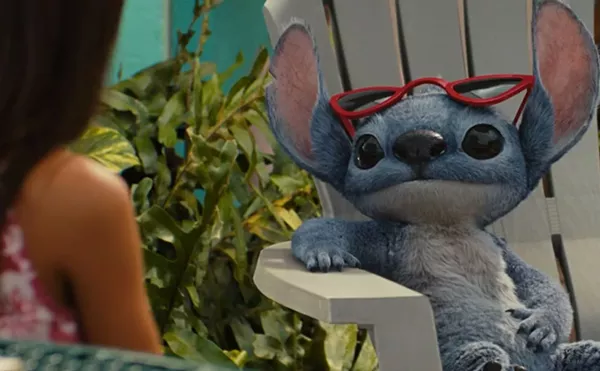
Audio By Carbonatix
[
{
"name": "GPT - Leaderboard - Inline - Content",
"component": "35519556",
"insertPoint": "5th",
"startingPoint": "3",
"requiredCountToDisplay": "3",
"maxInsertions": 100,
"adList": [
{
"adPreset": "LeaderboardInline"
}
]
}
]
The great Detroit debate over graffiti — art or crime? — shows no signs of simmering down. Not only artists and business owners but also police officers, Wayne County prosecutors and now a downtown landlord are in the midst of the controversy. The most recent flare-up is a piece of graffiti on the exterior wall of the Detroit Artists Market.
Last week, DAM commissioned graffiti artist Coupe, aka Michael Welch, 28, of Lac du Flambeau, Wis., to do his thing on the gray building housing the gallery at Woodward and Forest. Coupe was nabbed in June painting a vacant building near Interstates 75 and 94. He spent 60 days in the Wayne County jail for the offense (an experience he says “takes disgusting to a whole new level”), as County Prosecutor Michael Duggan made headlines and investigators used a subpoena in an attempt to force Coupe to cough up names of other Detroit graffiti artists, namely TRTL (a failed effort, Coupe says).
As part of a DAM exhibit that opened last week, Coupe tagged his name in signature flashy colors, adding a Detroit police badge and the names of the police officers, investigators and prosecutors — including Duggan — involved in his case. The piece is about 50 feet from — and faces — the 13th Precinct, the workplace of Coupe’s arresting officers.
The mural says, “The beauty of art and swift fair justice is in the eye of the beholder.”
Now the police are upset and angry. And a county prosecutor has visited the gallery to inquire about the piece, says Aaron Timlin, the gallery’s executive director.
The gallery’s landlord has demanded the graffiti be removed.
Timlin says he won’t take it down without a fight.
“Coupe is making a political statement,” says Timlin. “That’s very common in the art world, throughout history. This guy isn’t doing anything different than what the masters do. It’s art.”
DAM’s landlord, Lorna Abraham, didn’t return calls for comment. A county prosecutor said Coupe’s billboard missed the point: He wasn’t thrown in jail because of good or bad art, but because he broke the law.
Last year, Timlin helped launch Detroit’s public debate over graffiti when he offered a bounty for the apprehension of TRTL, a tagger or group of taggers who’ve marked all over the city with the now infamous, simplistic outline of a smiling turtle. Timlin was angered when TRTL marked a sculpture outside of DAM.
The gallery director says that most graffiti, such as Coupe’s, is art and deserves an outlet. But TRTL crossed the line into vandalism when he/she/they tagged other art and businesses downtown, he says. It’s ironic that Coupe’s arrest and internment were possibly linked to the public debate over TRTL.
Timlin obtained a $2,200 grant from the city to create a rotating art billboard, much like the one outside Ferndale’s Revolution Gallery, at the spot where Coupe painted. DAM’s landlord OK’d the plan, he says.
But when Abraham saw Coupe’s piece, she ordered it taken down, saying it was “ugly,” says Timlin.
The police drive by the mural upon entering and leaving their parking lot, and they’re not happy about it, says Officer Darrell Osborne of the 13th.
“The officers are not pleased,” says Osborne. “It’s kind of unfair. The officers were just doing their job.”
Graffiti is simply illegal when it’s on private property and without permission, Osborne says.
“I agree that some of it (graffiti) is artwork. It really is. But putting it on someone else’s property is not legal and it’s not fair to the property owner,” he says.
Two policemen who asked to remain anonymous say they’ve been pressured to find TRTL and other graffiti artists in the act. “We’ve got our marching orders,” says one officer.
Osborne says the cops won’t treat DAM unfairly because of Coupe’s piece.
“If we acted that way toward everyone who said something bad about us, we’d never leave the precinct,” he quips.
Coupe says investigators in his case were really after the identity of TRTL.
“That’s all they cared about,” he says.
He says his billboard “speaks for itself,” and isn’t meant to be vindictive.
“I don’t have any bad feelings toward anyone involved in my case, except maybe Duggan.”
He says the cops involved were “really good people, amazing people. I was amazed at how good they were to me.”
Graffiti is an artistic expression, Coupe says, and one he lives for.
“It helps me get through personal and mental problems. It helps me get through what I’ve been through in my life, things I’ve seen. Some people do drugs and get drunk, I do graffiti.”
Lisa M. Collins is the arts editor of Metro Times. Contact her at 313-202-8047 or lcollins@metrotimes.com




